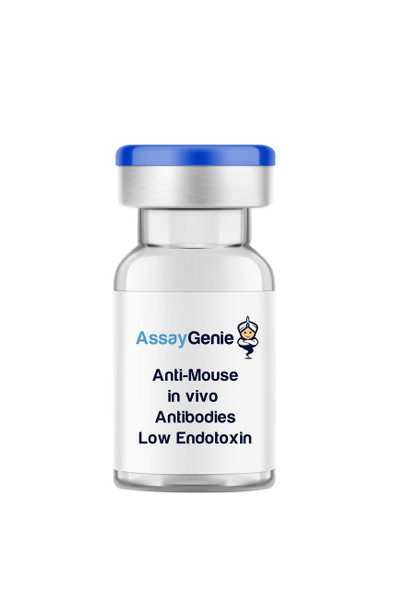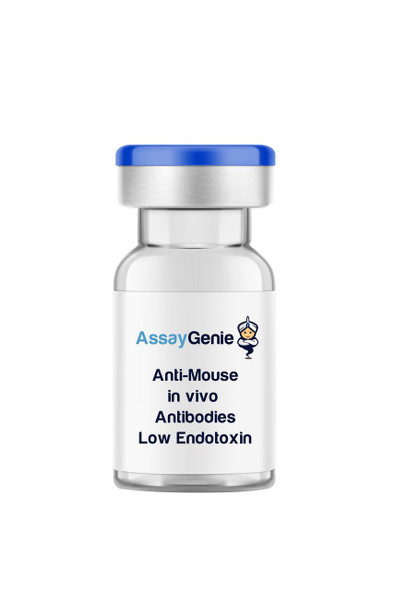Anti-Chikungunya E2 Protein In Vivo Antibody - Low Endotoxin (IVMB0341)
- SKU:
- IVMB0341
- Antibody Type:
- Functional-Grade In Vivo Antibody
- Disease Area:
- Cancer
- Clone:
- CHK152
- Protein:
- Chikungunya … E2
- Isotype:
- IgG2a k
- Reactivity:
- Mouse
- Synonyms:
- CHIKV
- Chikungunya virus
- VLPs
- Chikungunya virus-like particles
- Research Area:
- Chikungunya
- Infectious Disease
- Viral
- Endotoxin Level:
- Low Endotoxin
- Host Species:
- Mouse
- Applications:
- ELISA
- IHC
- In Vivo
- N
Description
Anti-Chikungunya E2 Protein In Vivo Antibody - Low Endotoxin
Introducing the Anti-Chikungunya E2 Protein In Vivo Antibody - Low Endotoxin from Assay Genie, a highly specific monoclonal antibody designed for in vivo applications. This antibody targets the E2 protein of the Chikungunya virus, crucial for viral entry and fusion, making it ideal for research in virology and infectious diseases. With a mouse IgG isotype, it ensures high purity and low endotoxin levels (<1.0 EU/mg), perfect for ELISA, neutralization assays, and other virological studies. Available in various sizes, it is formulated in phosphate-buffered saline for stability and efficacy.
Enhance your research with this reliable and versatile antibody. The E2 protein is an essential structural component of the Chikungunya virus, involved in the virus's ability to infect host cells. By targeting this protein, the Anti-Chikungunya E2 Protein In Vivo Antibody allows researchers to study viral pathogenicity and immune responses, contributing to the development of antiviral therapies and vaccines.
| Product Name: | Anti-Chikungunya E2 Protein In Vivo Antibody - Low Endotoxin |
| Product Code: | IVMB0341 |
| Size: | 1 mg, 5 mg, 25 mg, 50 mg, 100 mg |
| Clone: | CHK152 |
| Protein: | Chikungunya ⋅ E2 |
| Product Type: | Monoclonal Antibody |
| Synonyms: | CHIKV, Chikungunya virus, VLPs, Chikungunya virus-like particles |
| Isotype: | IgG2a k |
| Reactivity: | Mouse |
| Applications: | ELISA, IHC, In Vivo, N |
| Formulation: | This monoclonal antibody is aseptically packaged and formulated in 0.01 M phosphate buffered saline (150 mM NaCl) PBS pH 7.2 - 7.4 with no carrier protein, potassium, calcium or preservatives added. Due to inherent biochemical properties of antibodies, certain products may be prone to precipitation over time. Precipitation may be removed by aseptic centrifugation and/or filtration. |
| Endotoxin Level: | <1.0 EU/µg as determined by the LAL method |
| Purity: | ≥95% monomer by analytical SEC ⋅ >95% by SDS Page |
| Product Preparation: | Functional grade preclinical antibodies are manufactured in an animal free facility using in vitro cell culture techniques and are purified by a multi-step process including the use of protein A or G to assure extremely low levels of endotoxins, leachable protein A or aggregates. |
| Applications: | ELISA, IHC, In Vivo, N |
| Reactivity: | Mouse |
| Host Species: | Mouse |
| Specificity: | Clone CHK152 binds to and shows mechanisms of neutralizing1 of the Chikungunya E2 protein. |
| Antigen Distribution: | The E2 Envelope protein is expressed on the surface of the Chikungunya Virus |
| Immunogen: | Chikungunya E2 protein |
| Concentration: | ≥ 5.0 mg/ml |
| Endotoxin Level: | <1.0 EU/µg as determined by the LAL method |
| Formulation: | This monoclonal antibody is aseptically packaged and formulated in 0.01 M phosphate buffered saline (150 mM NaCl) PBS pH 7.2 - 7.4 with no carrier protein, potassium, calcium or preservatives added. Due to inherent biochemical properties of antibodies, certain products may be prone to precipitation over time. Precipitation may be removed by aseptic centrifugation and/or filtration. |
| Purity: | ≥95% monomer by analytical SEC ⋅ >95% by SDS Page |
| Preparation: | Functional grade preclinical antibodies are manufactured in an animal free facility using in vitro cell culture techniques and are purified by a multi-step process including the use of protein A or G to assure extremely low levels of endotoxins, leachable protein A or aggregates. |
| Storage and Handling: | Functional grade preclinical antibodies may be stored sterile as received at 2-8°C for up to one month. For longer term storage, aseptically aliquot in working volumes without diluting and store at -80°C. Avoid Repeated Freeze Thaw Cycles. |
Chikungunya virus (CHIKV) is a mosquito-transmitted alphavirus that causes epidemics globally and has been declared a notable disease by the CDC 1,2 . Symptoms include high fever, myalgia, rash, and severe polyarthritis which can persist for long after acute infection. CHIKV is an enveloped virus with an 11.8-kb single-stranded, positive-sense RNA genome with two open reading frames 3,4. There are three main genotypes, having 95.2 to 99.8% amino acid identity: Asian, West African, and East/Central/South African (ECSA). The mature CHIKV virion is comprised of a nucleocapsid protein C and two glycoproteins, E1 and E2 5. E1 participates in virus fusion. E2 functions in attachment to cells. E1 and E2 form 80 trimeric spikes on the virus surface 6.
Co-circulation of CHIKV with other arboviruses, such as dengue, Zika, Mayaro, and yellow fever, occurs in many countries, posing significant difficulties for diagnosis 2. Monoclonal antibodies (MAb) can be used both for diagnosis 7 and as a therapeutic agent 5,8,9. CHIKV can be rapidly detected by an immunochromatographic assay using MAbs against the CHIKV envelope protein 7. Additionally, MAb CHK-152 has been successfully used as a therapeutic agent in mouse 5 and macaque 9. CHK-152 activity is directed against the A domain of CHIKV E2 5 and likely neutralizes infectivity by inhibiting fusion 10.
MAb CHK-152 protects immunocompromised mice and macaque against CHIKV-induced mortality and disease, inhibiting all three CHIKV genotypes 5, 9. Viral loads are markedly reduced in serum, spleen, liver, muscle, and brain relative to controls and joint tissue appears normal 5, 8. Combination MAb therapy (CHK-102+CHK-152 or CHK-166+CHK-152), avoids the emergence of viral resistance (dominant single-mutation escape) in both mouse 5 and macaque models 9 and the treatment window is extended 5 . When humanized, hu-CHK-152 neutralizing activity and affinity for pE2-E1 are similar to mouse CHK-152 5.
| Protein: | Chikungunya ⋅ E2 |
| Research Area: | Chikungunya, Infectious Disease, Viral |
| Shipping: | 2-8°C |






